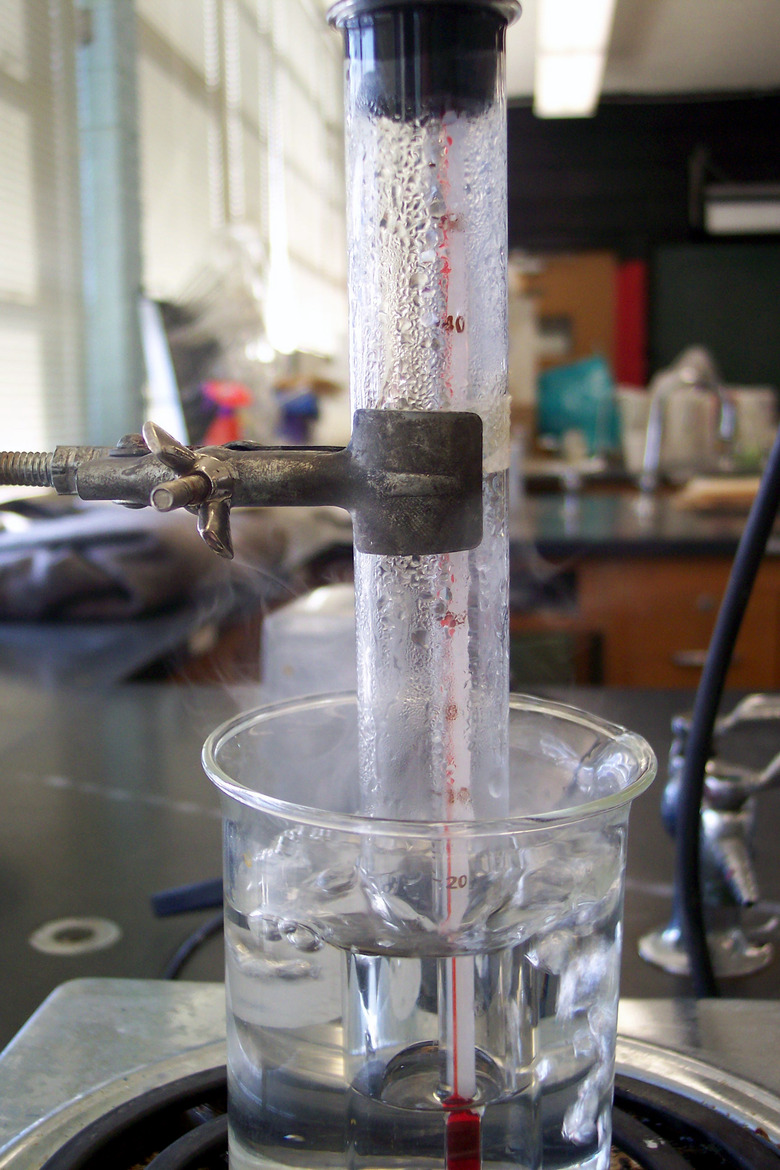How To Calculate Calorimeter Constant
If you're going to conduct an experiment to determine the amount of heat lost or gained in a chemical reaction or some other process, you have to do it in a container. The container, which is the calorimeter, could be a simple as a Styrofoam cup or as sophisticated as an explosion-proof container immersed in water. Either way, it will absorb some of the heat, so it's important to calibrate it before you conduct your experiment. The calibration gives you a number called the calorimeter constant. It's the amount of heat energy required to raise the temperature of the calorimeter by 1 degree Celsius. Once you know this constant, you can use the calorimeter to measure the specific heat of other materials.
Determining the Calorimeter Constant
Determining the Calorimeter Constant
When you combine a quantity of a substance with the same quantity of the same substance at a different temperature and measure the equilibrium temperature, you should find it to be midway between the initial temperatures. That's an idealization, though. In reality, some of the heat gets absorbed by the calorimeter.
One way to calibrate a calorimeter is by mixing two quantities of water in it at different temperatures and recording the equilibrium temperature. Water works well for this purpose because it has an easy-to-handle specific heat (Cs) of 1 calorie per gram per degree Celsius (4.186 Joules/g ˚C). Pour in a known quantity of hot water (m1) into a calorimeter containing a known quantity of cold water (m2) and record the equilibrium temperature of the mixture. You'll find the heat lost by the warm water is more than the heat gained by the cold water. The difference is the heat absorbed by the calorimeter.
The hot water loses an amount of heat energy given by q1 = m1CS∆T1, and the cold water gains an amount equal to q2 = m2CS∆T2. The amount the calorimeter absorbs is (q1 – q2) = (m1 CS∆T1 ) – (m2CS∆T2). The temperature of the calorimeter rises by the same amount as the cold water, so the heat capacity of the calorimeter, which is the same as the calorimeter constant (cc), is (q1 – q2) ÷ ∆T2 cal/g ˚C or
cc = CS (m1∆T1 + m2∆T2) ÷ ∆T2 cal/g ˚C
Measuring Specific Heat
Measuring Specific Heat
Once you know its heat capacity, you can use a calorimeter to calculate the specific heat of an unknown substance. Heat a known mass of the substance (m1) to a specific temperature (T1). Add it to the calorimeter in which you've already placed another mass of the same substance (m2) at a cooler temperature (T2). Wait for the temperature to come to equilibrium and record that equilibrium temperature (TE).
You find the specific heat of the substance by using the above equation, rearranged to solve for CS.
CS = (cc • ∆T2) ÷ (m1∆T1 + m2∆T2) cal/g ˚C.
Cite This Article
MLA
Deziel, Chris. "How To Calculate Calorimeter Constant" sciencing.com, https://www.sciencing.com/how-to-calculate-calorimeter-constant-13710547/. 23 March 2018.
APA
Deziel, Chris. (2018, March 23). How To Calculate Calorimeter Constant. sciencing.com. Retrieved from https://www.sciencing.com/how-to-calculate-calorimeter-constant-13710547/
Chicago
Deziel, Chris. How To Calculate Calorimeter Constant last modified August 30, 2022. https://www.sciencing.com/how-to-calculate-calorimeter-constant-13710547/
